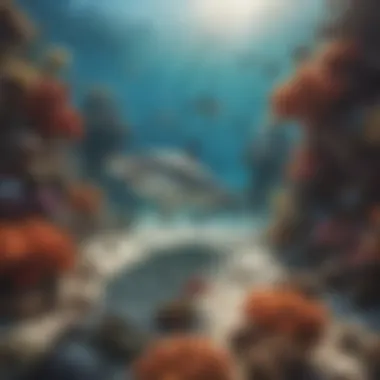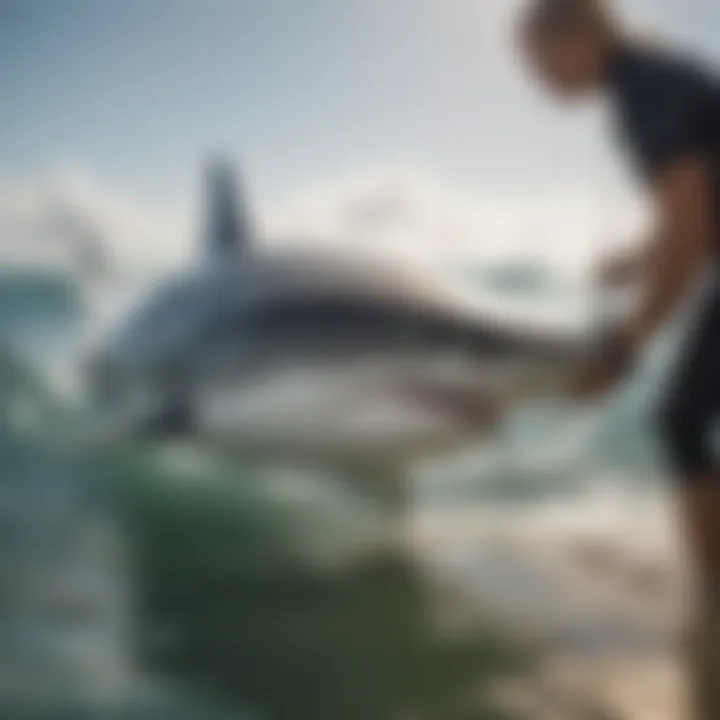A Comprehensive Exploration of Sharks in Our Oceans


Intro
Sharks have captured the imagination of many, partly due to their imposing presence in the ocean. But beyond their reputation as fearsome predators, they play a crucial role in maintaining the health of marine ecosystems. This exploration seeks to peel back the layers on these fascinating creatures, offering insights into their biology, behavior, and the vital functions they serve in our waters.
The examination starts with understanding the diverse array of shark species that exist, from the colossal whale shark to the diminutive dwarf lantern shark, each uniquely adapted to their environment. It also digs into their natural habitats, which range from coastal waters to the deep sea.
Furthermore, we’ll tackle the pressing threats facing sharks today. Overfishing, habitat destruction, and the infamous practice of finning are just a few issues that pose risks to their survival. Yet, there are ongoing efforts in conservation that aim to protect these vital marine inhabitants, emphasizing collaborative efforts from various communities worldwide.
This article will also delve into how different cultures perceive sharks, shaping narratives that impact their conservation status. In some cultures, sharks are revered, while in others, they are viewed with fear. This cultural lens can inform how we approach shark conservation efforts globally.
In short, this article does not only inform but also aims to evoke an appreciation for sharks, urging readers to recognize their significance in our oceans and the urgent measures required to ensure their preservation.
Prolusion to Sharks
Sharks have long captivated the imagination of mankind, serving both as subjects of fascination and fear. Understanding sharks goes beyond mere interest; it's crucial for grasping the ecological dynamics of our oceans. In this section, we will explore fundamental aspects that underscore the significance of studying sharks, including their evolutionary journey and their representation in culture.
The importance of sharks extends well into the realms of biology, ecology, and even mythology. With over 500 species varying from the mighty great white to the minute dwarf lanternshark, each plays a role in maintaining the balance of marine ecosystems. By delving into their intricacies, we uncover the benefits directly linked to their existence, such as their contributions to biodiversity and the health of fish populations.
The Evolution of Sharks
Sharks' evolution is a captivating saga that stretches back roughly 400 million years, predating the dinosaurs. They have weathered several mass extinctions, continuously adapting to environmental changes. One can draw parallels between sharks and the proverbial tortoise and the hare—they may not be the flashiest creatures, but their longevity and adaptability speak volumes about their resilience.
Their anatomical adaptations are especially fascinating. For instance, some sharks have developed a unique method for hunting in deep water, utilizing electrosensitivity to detect the faintest electric signals emitted by potential prey. This ability has been key to their success over eons, allowing them to thrive in virtually every marine habitat.
Key Points of Interest:
- Sharks possess a skeleton made of cartilage, which is much lighter than bone, improving their buoyancy.
- The evolutionary pathway of sharks includes transformations that enable them to occupy diverse ecological niches.
- Some species, like the hammerhead, developed unique head shapes that enhance their hunting efficiency.
Understanding shark evolution is vital because it highlights their adaptive strategies amidst changing environments. These insights are increasingly important in light of current environmental challenges that threaten their survival.
Sharks in Popular Culture
Sharks have carved a notable niche in popular culture, often depicted as ferocious predators. Movies like Jaws shaped public perception, imbuing sharks with a stereotype that has often veered towards the sensationalist. However, this portrayal doesn’t reflect reality, and such depictions can lead to harmful misconceptions about these animals.
Despite their negative representation, sharks have also emerged as symbols of strength and resilience in various contexts. For example, surf culture often glorifies the idea of the shark as an essential part of the ocean experience, celebrating the thrill of encounters, whether through surfing or diving. In literature and art, sharks evoke deeper themes of the fear of the unknown and the challenges of coexistence with nature.
"The shark is often misunderstood, representing a constant reminder of the wildness of the ocean, challenging humanity’s perception of nature and our place within it."
Noteworthy Points:
- Sharks function as metaphors in literature, embodying the fears and challenges inherent in our relationship with the sea.
- Various documentaries serve to educate the public about sharks' ecological importance, encouraging a shift from fear to respect.
- Public awareness campaigns have sprung up to correct misinformation and promote shark conservation.
In essence, sharks in popular culture serve as a double-edged sword: they can reinforce fear, yet they provide valuable opportunities for education and awareness about marine conservation. As we navigate further into this exploration, understanding the evolution and cultural perceptions of sharks adds layers to our appreciation of these remarkable creatures.
Diversity of Shark Species
The diversity of shark species is a captivating topic within marine biology, as it showcases the vast array of evolutionary adaptations and survival strategies that have allowed these creatures to thrive in various aquatic environments. Recognizing the many species of sharks, from the well-known Hammerhead to the rare Goblin shark, offers insights into their roles in ecosystems and underscores the importance of preserving their populations. Understanding this diversity is crucial for both conservation efforts and the broader comprehension of marine life dynamics.
Common Species of Sharks
When we discuss common species of sharks, we're diving into a pool filled with both familiar faces and surprising secrets. Some sharks, like the Great White and the Tiger shark, have earned their place in the spotlight due to their size and popularity in media. Here are a few notable examples:
- Great White Shark: Known for its robust body and powerful bite, this shark is often depicted as the apex predator. Great Whites primarily inhabit coastal waters and are renowned for their hunting skills, using a breach-and-attack technique.
- Tiger Shark: Easily recognized by the dark stripes on its back, the Tiger shark is notorious for its opportunistic feeding habits. It can be found in tropical and subtropical waters, taking a wide range of prey, from fish to even inedible objects.
- Hammerhead Shark: This species is distinguished by its unique head shape, which aids in locating prey. Hammerheads are social creatures that often swim in schools, especially during mating season.
Familiarity with these common species provides an essential foundation for appreciating the complexities of sharks in marine ecosystems. Each species has its own behavioral patterns and ecological roles, contributing to the overall health of ocean environments.
Rare and Unusual Species
Not all sharks fit the typical mold found in documentaries or marine exhibits. Numerous rare and unusual species exhibit remarkable features and behaviors that provoke intrigue. The following are a few instances that may shift the way we view these amazing creatures:
- Goblin Shark: With a long, flattened snout and protruding jaw, the Goblin shark looks like something out of a science fiction movie. Rarely encountered in the wild, it primarily resides in deep waters, making it elusive and mysterious.
- Frilled Shark: Often referred to as a "living fossil", the Frilled shark has an elongated body and frilled gills. It can be found in deep sea environments and is known for its unique and primitive appearance, which harks back to the era of dinosaurs.
- Cookiecutter Shark: This small shark, named for its unique bite marks that resemble cookie cutter shapes, is often found in deep waters around the world. It has a fascinating feeding technique, removing plugs of flesh from larger animals, making it a misunderstood but important player in marine ecology.


Understanding these rare sharks helps deepen our appreciation for the vast ocean biodiversity and the critical roles that even the strange and less-known species play.
Shark diversity is emblematic of the adaptations necessary for survival in varying aquatic ecosystems. From the familiar to the obscure, these species' unique characteristics and habits enrich the tapestry of marine life, reminding us of the importance of their conservation in a rapidly changing world.
Anatomy and Physiology of Sharks
Understanding the anatomy and physiology of sharks is crucial for grasping their ecological role and adaptations as marine predators. This section highlights the unique features that enable sharks to dominate their environment, showcasing not only their physical attributes but also their evolutionary advantages. Given their long-standing presence in the oceans, studying these aspects reveals much about their survival and importance in maintaining the balance within marine ecosystems.
Physiological Adaptations
Sharks exhibit a range of fascinating physiological adaptations that make them exceptionally well-suited to life in the ocean. One of the most notable adaptations is their body shape. Equipped with sleek, torpedo-like bodies, sharks can glide effortlessly through water, reducing drag and allowing them to reach impressive speeds. This streamlined form is particularly beneficial during hunting, enabling them to ambush prey with startling bursts of energy.
Additionally, sharks possess rows of sharp, replaceable teeth that help them effectively grasp and tear their food. Each species has teeth that are uniquely adapted to its dietary habits; for instance, great white sharks have serrated teeth ideal for cutting through flesh, while whale sharks have flat teeth designed for filter-feeding on plankton. Such specializations underscore the versatility and adaptability of sharks across various marine environments.
Moreover, sharks have an extraordinary ability to regulate their buoyancy. Unlike bony fish that rely on swim bladders to control depth, sharks utilize large livers filled with oil. This adaptation allows them to maintain stability at varying depths without expending excessive energy. Their unique fin structure also plays a role in ensuring balance and maneuverability while swimming, allowing them to perform agile turns and swift movements.
"The physiology of sharks showcases an incredible harmony between adaptation and function, ensuring their position at the top of the food chain."
Sensory Abilities
The sensory abilities of sharks are remarkable, granting them a distinct advantage as apex predators. They are equipped with several specialized senses, each fine-tuned for detecting prey in the often murky depths of the ocean. Sharks have an acute sense of smell, which is thought to be up to 10,000 times more sensitive than that of humans. They can detect blood and other bodily fluids from miles away, allowing them to locate injured prey or feeding frenzies even in dark environments.
Additionally, their ability to perceive vibrations is enhanced by the lateral line system. This series of fluid-filled canals along their sides detects minute changes in water pressure, enabling sharks to sense the movement of potential prey nearby. This sensitivity to vibrations is not merely a supportive ability; it is often the difference between life and death in a predatory scenario.
Another impressive feature is the ampullae of Lorenzini, electroreceptors that allow sharks to detect the electric fields produced by other organisms in the water. This adaptation is particularly useful for hunting prey hiding beneath the ocean floor, as it gives sharks a way to "see" through obstacles that might otherwise conceal their catch.
In summary, the anatomy and physiology of sharks are exquisite examples of evolutionary success. From their hydrodynamic forms and buoyancy control to their advanced sensory systems, these adaptations contribute to their status as some of the ocean's most efficient hunters.
Shark Behavior and Ecology
Understanding shark behavior and ecology is crucial for appreciating their role in marine ecosystems. Sharks, as apex predators, help maintain the balance in oceanic environments. Their feeding habits, social structures, and migration patterns all play significant roles in shaping marine biodiversity and health. By exploring these behaviors, we can gain insights into how sharks interact with their surroundings and the implications for conservation efforts.
Feeding Habits
Sharks exhibit diverse feeding habits, reflecting their adaptability to various habitats and prey availability. Generally, they can be categorized into three main feeding strategies:
- Carnivorous: Many sharks are strict carnivores, feeding primarily on fish, squid, and sometimes marine mammals. For instance, the great white shark predominantly hunts marine mammals like seals, thanks to its powerful bite and keen sense of sight.
- Planktivorous: A smaller group, such as the whale shark and basking shark, feeds mainly on plankton. They possess specialized filtering systems to retain these tiny particles while swimming with their mouths wide open.
- Omnivorous: Some species, like the tiger shark, have more varied diets. They consume everything from fish and squid to birds and even non-food items, showcasing a unique adaptability that allows them to thrive in different environments.
The way sharks feed directly impacts marine populations. By controlling the numbers of mid-tier predators and preventing overgrazing of marine herbivores, sharks contribute to ecological health. Their predation helps maintain healthy coral reefs and kelp forests, which are vital for ocean ecosystems.
Social Structures
When it comes to social behavior, sharks aren't usually seen as social creatures. However, several species do exhibit fascinating social structures. For instance:
- Group Living: Species like hammerhead sharks are known to form schools. These groups can provide safety through numbers, confusing predators and enhancing hunting efficiency.
- Hierarchical Structures: In some cases, like with the blacktip reef sharks, there can be a hierarchy within groups during feeding. Larger individuals often dominate meal time, thus displaying elements of social order.
- Mating Rituals: Social interactions are also evident during mating periods. Courtship may involve unique behaviors, such as biting, to establish dominance among males.
Understanding these structures sheds light on how sharks coexist with one another and navigate their ecosystems, emphasizing the need for their conservation amidst declining populations.
Shark Migration Patterns
The migration patterns of sharks reveal their adaptability and highlight crucial ecological relationships. Many species undertake vast migrations driven by various factors:
- Breeding: Certain sharks migrate long distances to specific breeding grounds. For example, the blacktip sharks in the western Atlantic move to shallow coastal waters to give birth. This behavior secures a safer environment for their young, who are more vulnerable in the open ocean.
- Food Availability: Sharks often follow prey migrations, which can lead them to varying locations throughout the year. The great white, for instance, migrates along the California coast to follow seals as they come and go.
- Environmental Changes: Changes in water temperature and other climatic factors also influence migration. Warmer waters invite sharks to inshore areas, creating a dynamic that beachgoers need to be aware of, especially for those involved in activities like surfing or swimming.
"Sharks are not merely products of evolution; they are pivotal players in maintaining the ecological harmony of our oceans."
In sum, exploring shark behavior and ecology reveals the intricate ways these animals influence and are influenced by their environments. Engaging with their feeding habits, social interactions, and migration patterns can enhance our understanding of these organisms, underscoring why they are deserving of protection on a global scale.
Sharks and Their Marine Environments
Understanding sharks and their marine environments is critical not just for conservationists but for anyone who enjoys our oceans. Sharks are more than just apex predators; they play pivotal roles in maintaining the health of marine ecosystems. Their interactions with various species and environment emphasize the interconnectedness of marine life. To grasp their importance, we must explore their habitat preferences, the specific roles they occupy in ecosystems, and the ripple effects of their behaviors and populations on the marine world.
Habitat Preferences


Sharks possess diverse habitat preferences shaped by their physiological adaptations and ecological needs. From coastal shallows to the deep ocean, sharks can be found across a variety of environments. For instance, species like the great white shark often favor the nutrient-rich coastal waters where they hunt seals. In contrast, smaller species such as the epaulette shark thrive in shallow, sandy areas of coral reefs.
- Coastal Waters: Many sharks flourish in these areas due to abundant food sources, like fish and crustaceans. This includes bull sharks and tiger sharks, which are known for their flexibility in diet.
- Open Ocean: Species such as the blue shark prefer deeper waters, often traveling long distances in search of prey.
- Estuaries and Mangroves: Juvenile sharks, like the blacktip reef shark, often inhabit these nurseries as they provide safety from predators while offering ample prey.
"Sharks are the lifeblood of marine ecosystems. Without them, the balance would tip, leading to overpopulation of certain species and the decline of others."
Understanding these habitat preferences helps marine biologists identify critical areas that need protection. As habitats face increasing threats from pollution and development, knowing where sharks are most vulnerable is crucial for effective conservation strategies.
Role in Ecosystem Dynamics
The role of sharks in ecosystem dynamics cannot be overstated. As apex predators, they are responsible for maintaining the balance within marine food webs. Their predation helps regulate the populations of other species, preventing the overgrowth of certain fish that could lead to ecosystem collapse. For instance, the removal of sharks from an area may lead to an increase in herbivorous fish species which can overgraze kelp forests, ultimately affecting the entire habitat.
- Top-Down Regulation: Sharks control prey populations, which in turn affects the abundance and health of the species below them in the food chain. A decline in shark populations can lead to an increase in mid-level predators, which may decimate smaller fish populations, disrupting the entire ecosystem.
- Scavenging: Some smaller shark species take on roles as scavengers, helping to clean up dead marine animals, which is vital for nutrient cycling.
- Indicator Species: Sharks also serve as indicators of ocean health. Changes in their population can signal alterations in the marine environment, prompting needed research and action.
In summary, both their habitat preferences and roles in ecosystem dynamics illustrate why sharks are integral to the marine environment. Protecting these areas and understanding their functions can lead to healthier oceans. As we deal with various threats like climate change and habitat degradation, it’s essential to keep sharks in mind. After all, when sharks thrive, so too does the ocean.
Human Interaction with Sharks
In a world where ecosystems are rapidly changing, understanding human interaction with sharks is more vital than ever. As apex predators, sharks play an essential role in maintaining the balance of marine environments. However, their relationship with humans is multifaceted, involving both positive and negative aspects. This section delves into the significance and complexity of human interactions with these enigmatic creatures, emphasizing the necessity for a thoughtful approach in managing their populations and habitats.
The Commercial Shark Fishing Industry
The commercial shark fishing industry stands at the crossroads of economic gain and ecological responsibility. With billions of dollars at stake, the demand for shark meat, fins, and other products has skyrocketed in recent years. Shark fins, in particular, have become a delicacy in many Asian countries, leading to unethical practices like finning, where sharks are caught, their fins removed, and the bodies discarded; it's like throwing away money while keeping the change. This market-driven approach has resulted in severe population declines among numerous shark species.
- Economic Impact: The commercial value of sharks has kept the fishing industry alive, but at what cost? Fishermen can earn significantly more from selling shark fins rather than just the meat. This has incentivized unsustainable practices that threaten shark populations worldwide.
- Regulatory Challenges: Governments and international bodies face a tough task in regulating this industry. While some countries have imposed restrictions, enforcement remains a significant hurdle. Without global cooperation, the effectiveness of these measures is put to the test, resembling a game of whack-a-mole where every solution feels temporary.
- Bycatch Concerns: Alongside targeted shark fishing, bycatch—where non-target species are unintentionally captured—adds another layer of complexity. Many juvenile sharks and vulnerable species become collateral damage in the pursuit of profit.
Shark Tourism and Conservation
On the flip side, shark tourism has emerged as a powerful tool for conservation. Tourists flock to dive sites renowned for their shark populations, often paying handsomely for the opportunity to swim with these majestic creatures. This shift toward ecotourism presents a promising alternative to exploitative practices.
- Economic Incentives for Preservation: Communities around marine environments are discovering that live sharks can be more valuable than dead ones. In places like the Bahamas and South Africa, the thriving shark tourism industry creates jobs and spurs local economies, laying the groundwork for conservation efforts. Rather than emptying the ocean's wallet, it's about putting money back into it.
- Raising Awareness: Shark tourism also fosters awareness about the importance of sharks in marine ecosystems. Visitors often leave with a newfound respect for sharks, turning them into advocates for their protection. Programs are designed to educate participants on shark behavior, biology, and their crucial role in ocean health. It’s not just about diving; it's about diving into the deeper waters of understanding.
- Local Community Involvement: Successful shark tourism relies heavily on local involvement. Residents' participation in conservation and tourism activities creates a sense of ownership and stewardship over the ocean, turning these communities into guardians rather than detractors of the oceans they inhabit.
The relationship between sharks and humans can serve as an example of how coexistence is possible when informed by respect and understanding. Investing in life can often yield richer rewards than taking lives.
While these two facets of human interaction with sharks show contrasting routes, the future of shark populations hinges on balancing economic interests with genuine conservation efforts. It will take collective action, innovative thinking, and awareness to shape a future where sharks and humans can thrive side by side.
Threats to Shark Populations
Understanding the threats to shark populations is crucial, not just for their survival but also for the health of marine ecosystems. Sharks, as top predators, play an integral role in maintaining the balance of oceanic life. A decline in their numbers can lead to significant changes in the marine environment, causing a ripple effect that impacts numerous species. The conversation around these threats involves various dimensions—overfishing, habitat degradation, and climate change—all of which are interlinked and have profound implications for the future of sharks.
Overfishing and Bycatch
Overfishing represents a remarkably serious threat to sharks. Due to their slow reproductive rates and late maturity, shark populations struggle to recover from intense fishing pressure. Fishermen often target sharks for their fins, meat, and liver oil, leading to drastic declines in certain species.
Bycatch, or the unintentional capture of non-target species, adds another layer of complexity. Sharks commonly end up caught in nets and fishing lines meant for other fish. This incidental capture can be devastating, not just for sharks but for the entire ecosystem they inhabit. The United Nations Food and Agriculture Organization has reported alarming statistics; hundreds of thousands of sharks are caught each year as bycatch, with many left to die after being tossed back.
The impact of overfishing is compounded by the high demand for shark products in culinary circles, leading to extensive underground markets. As a result, species like the hammerhead and tiger shark face significant threats to their populations. Protecting sharks from overfishing and minimizing bycatch is vital for their conservation. Efforts such as implementing stricter fishing regulations can help bolster these struggling populations.
Habitat Degradation
The habitats that sharks call home are under siege from several fronts, primarily due to human activities. Coastal development, pollution, and destructive fishing methods wreak havoc on essential habitats like coral reefs, seagrasses, and mangroves. These environments serve as breeding grounds and nurseries for many shark species.
Pollutants, such as plastics and chemicals entering the oceans, reduce water quality and threaten the delicate ecosystems where sharks and their prey reside. When these habitats are compromised, the implications extend beyond the sharks; entire marine communities, including fish stocks and invertebrates, bear the brunt of habitat degradation. Marine Protected Areas (MPAs) are being promoted as valuable tools in combating this issue. However, they require stringent monitoring and enforcement to ensure their effectiveness.
Climate Change Impact
Climate change is becoming an increasing multi-faceted threat to sharks. As ocean temperatures rise, shark migration patterns shift, altering the dynamics of marine ecosystems. Some species may find their food sources depleted, while others might face new competition for resources in their adjusted ranges. Moreover, increasing ocean acidity directly impacts the prey that sharks depend on.
Furthermore, coral bleaching and habitat loss linked to climate change jeopardize the ecosystems that support shark populations. The increase in extreme weather events also threatens coastal habitats, further compounding the challenges that sharks face.
Addressing climate change is an immense undertaking, yet it is essential for the long-term survival of many shark species. Promoting sustainable practices, reducing greenhouse gas emissions, and raising awareness about the consequences of climate change are pivotal steps needed to protect both sharks and their ocean environments.
"In the grand tapestry of oceanic life, sharks are not just threads; they are the very fabric that holds the ecosystem together. Losing them would unravel the delicate balance we all depend upon."


Conservation Efforts
Conservation efforts play a crucial role in the survival of shark populations and the broader marine ecosystem. As apex predators, sharks help maintain the balance of oceanic life. Protecting them is not just about saving a species; it encompasses preserving the very fabric of marine biodiversity. These efforts are increasingly essential, considering the numerous threats sharks face today, including overfishing, habitat degradation, and the impacts of climate change.
Global Initiatives and Regulations
Around the world, various global initiatives and regulations aim to protect shark species and their habitats. Organizations such as the Convention on International Trade in Endangered Species (CITES) regulate international trade of certain shark species, ensuring that their commercial exploitation does not threaten their survival.
Moreover, regional agreements, like the Shark Conservation Act in the United States, focus on preventing shark finning. This practice, driven by high demand for shark fins in Asia, poses a significant risk to many species. The legislation prohibits the removal of shark fins at sea, mandating that sharks be brought to shore with their fins attached, thereby promoting responsible fishing practices.
In addition, educational campaigns are vital in raising awareness on the importance of sharks. Efforts from groups like the Shark Trust foster a better understanding of shark biology and ecological roles, connecting conservation work directly to local communities and stakeholders. Educating the public about sustainable seafood choices also plays a part in mitigating overfishing.
The Role of Marine Protected Areas
Marine Protected Areas (MPAs) serve as safe havens for sharks and other marine life. These designated regions are crucial for replenishing depleted populations and allowing ecosystems to recover from human-induced damage. Many MPAs restrict activities like fishing, thereby providing essential breeding and nursery habitats where juvenile sharks can grow and thrive.
Some notable examples include:
- The Galápagos Marine Reserve: Home to diverse shark species, including the elegant hammerhead, this area has been pivotal in studying shark behavior and health.
- The Bahamas: Enacting a ban on shark fishing, this nation has become a key player in shark conservation and ecotourism efforts.
"Establishing marine protected areas is not just beneficial for sharks; it's essential for the entire health of the ocean." - Marine Ecologist
Though the establishment of MPAs shows promise, ongoing monitoring is fundamental. Research indicates that the success of these protected areas often hinges on local involvement and compliance. Engaging communities in conservation efforts not only empowers them but can also provide them with economic benefits through sustainable tourism practices, connecting their livelihoods to healthy shark populations.
Cultural Perceptions of Sharks
Understanding the cultural perceptions of sharks is vital as it weaves together not just the biological realm, but also the emotional and psychological connections humans have with these creatures. Sharks are often viewed through various lenses, influenced by culture, geography, and societal narratives. This section explores how these perceptions shape conservation efforts, public awareness, and, ultimately, the future of sharks.
Sharks in Mythology and Folklore
From ancient tales woven in coastal villages to modern urban legends, sharks have played a significant role in mythology and folklore across the globe.
- In Hawaiian mythology, Kāne is the god of freshwater and an advocate for sharks, representing them as protectors of the ocean. The belief among the locals is that sharks are the reincarnations of their ancestors, which instills a sense of respect and reverence for these creatures.
- Similarly, the Māori of New Zealand have stories of Mako sharks guiding their ancestors through their journeys. These tales serve as a reminder of the deep connection between humans and marine life, often emphasizing the need for harmonious coexistence.
On the flip side, sharks have also appeared in cautionary stories. The infamous Jaws is a prime example: the depiction of sharks as ruthless predators left an indelible mark on societal fears. Such narratives often overshadow the ecological realities, leading to misconceptions about the nature of these creatures.
"Sharks embody both fear and reverence; they are not just creatures of the deep but symbols that reflect our relationship with nature."
Sharks in Literature and Art
In literature and visual arts, sharks emerge as powerful symbols embodying primal fears, profound respect, and awe. Authors and artists have drawn inspiration from sharks, depicting them in myriad ways.
In literature, writers like Ernest Hemingway have referenced these creatures, not just as fish but as a representation of humanity’s struggle against nature. Shark symbolism often implies strength and ferocity but can also evoke vulnerability when viewed through various character arcs.
Art also reflects these dual narratives. The breathtaking mural work of oceanic artists highlights sharks' beauty, often adorned with vibrant colors, contributing to a positive perception of sharks as essential marine inhabitants rather than mere predators.
- Works such as the famous painting "The Great White Shark" by John McNaughton represent these fish in a way that showcases their elegance rather than horror.
- Additionally, the presence of sharks in documentaries and films like Blue Planet reshapes the narrative towards a conservationist viewpoint. Such productions present sharks as vital components of marine ecosystems, deserving admiration and protection.
Through these diverse representations, sharks become a medium to explore our own fears, aspirations, and the call for conservation - influencing how society views sharks today.
Future of Sharks
The future of sharks holds vital significance not just for marine ecosystems but also for human societies that depend on healthy oceans. As apex predators, sharks play a crucial role in regulating the populations of various marine species. Their decline could provoke a domino effect on ecosystem balance, leading to overspills of certain fish species and starvation of others. Thus, understanding the trajectory of shark populations and the contributing factors is paramount for conservation efforts.
For those involved in marine biology, conservation, and even ocean sports like surfing or diving, the fate of sharks is deeply intertwined with their own activities. The ongoing research and adaptive strategies being developed will shape not just the survival of shark populations, but also the health of oceans worldwide. Therefore, examining the future of these magnificent creatures provides us with tangible insights into ecological stewardship and sustainable practices.
Research and Technological Advances
Innovation in research and technology has paved new pathways for studying sharks, promising to enhance our understanding of their biology and behaviors. Advances like satellite tagging and underwater drones have revolutionized data collection, allowing scientists to track shark movements in real-time. These tools enable researchers to gather precise data on migration patterns and reproductive habits, vital for formulating effective conservation strategies.
Furthermore, genetic techniques shed light on species diversity, enabling researchers to identify populations and genetic variations that are crucial for their survival. The continued development of monitoring technologies ensures that we can better predict shark responses to environmental pressures, from climate change to habitat destruction. One cannot overstate how these scientific strides are breeding hope for the future of sharks, giving us a fighting chance to protect them from the myriad of threats they face today.
"Conservation efforts are only as good as the knowledge that underscores them; technology keeps us a step ahead in the game of survival."
The Importance of Public Awareness
Public awareness about the significance of sharks in marine ecosystems is fundamental to their conservation. As informed advocates, surfers, lifeguards, and beachgoers can play a critical role in shaping perceptions and policies. Education initiatives are essential for dispelling myths surrounding shark attacks, which often overshadow their ecological importance. Media campaigns, school programs, and community outreach can foster a more nuanced understanding of sharks, helping to build appreciation for these creatures.
Communities that engage with shark conservation are more likely to support protective measures, such as establishing marine protected areas or advocating against overfishing. When local populations recognize the symbiotic relationship they share with sharks, they become proactive in safeguarding their oceans.















